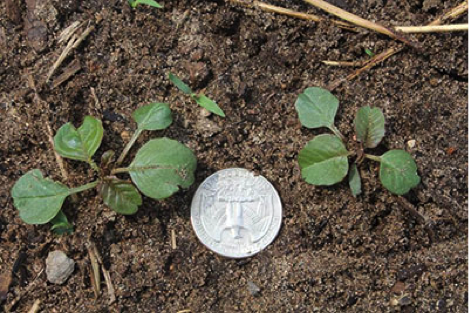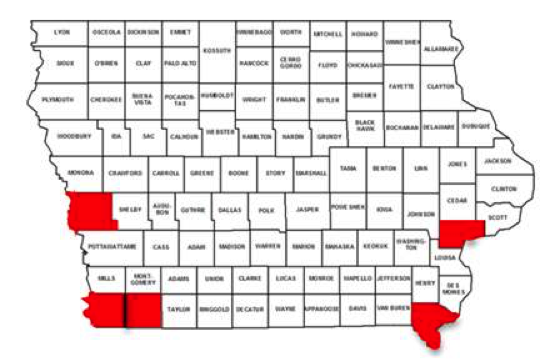Source: Iowa State University Extension
By Meaghan Anderson, Field Agronomist
Palmer amaranth has been confirmed in five Iowa counties over the last two summers. The only (known) infestation in Muscatine County is on a very sandy soil near the Cedar River, and most emerged seedlings had at least four true leaves on May 4, 2015.
This particular infestation has been intensively managed for just over a year, resulting in a significant decrease in its presence at the farm. This is very encouraging that with early discovery and good management, eradication may be possible.
While the seedlings in this picture appear quite distinctive with their long petioles and round leaves, we would not suggest that identification of a population at this seedling stage is easy or even possible.
The presence of Palmer amaranth in this area previously gives us confidence that the seedlings seen on May 4 are Palmer amaranth and not another of the many Amaranthus species present in the state. The Palmer amaranth in this field is much larger than waterhemp observed in other fields.

Two Muscatine Co. Palmer amaranth seedlings with at least four true leaves on May 4, 2015.

Five counties with confirmed Palmer amaranth infestations.
When scouting for Palmer amaranth, key vegetative characteristics to look for would be a lack of hairs on stems, ovate-shaped leaves, and the presence of petioles longer than the leaf blades. Bob Hartzler, Iowa State Extension Weed Scientist, has put together a number of materials to assist in Palmer amaranth identification that can be found at this link:
Palmer amaranth identification
Many other Amaranthus species are present in Iowa, including redroot pigweed (Amaranthus retroflexus), smooth pigweed (Amaranthus hybridus), waterhemp (Amaranthus tuberculatus), and spiny amaranth (Amaranthus spinosus), among others.
These Amaranths have significant genetic variability, often making it nearly impossible to distinguish many individuals without the presence of inflorescences. Luckily, or unluckily, Palmer amaranth is expected to begin flowering in Iowa in late June to early July.
While it has only been confirmed in five counties, we suspect that it is present in much more of the state already. Likely areas of infestation would be near cattle or swine operations that import feed or bedding from southern states, especially those that use cottonseed products or gin trash.
Two of the known infestations are near commercial grain handling operations; Palmer amaranth seed may have been brought on trucks transporting grain from areas with Palmer amaranth infestations.
Please keep an eye out for this weed while scouting this summer.
If you find a suspicious population of Amaranths, please contact your local Iowa State University Extension Field Agronomist or Bob Hartzler (515-294-1164).






Post a comment
Report Abusive Comment